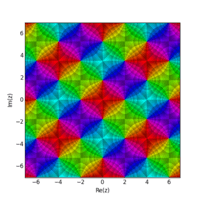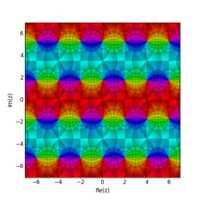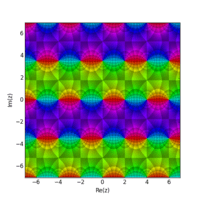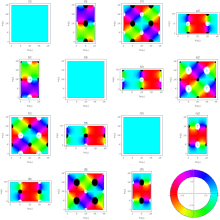Jacobi elliptic functions
In mathematics, the Jacobi elliptic functions are a set of basic elliptic functions, and auxiliary theta functions, that are of historical importance. They are found in the description of the motion of a pendulum (see also pendulum (mathematics)), as well as in the design of the electronic elliptic filters. While trigonometric functions are defined with reference to a circle, the Jacobi elliptic functions are a generalization which refer to other conic sections, the ellipse in particular. The relation to trigonometric functions is contained in the notation, for example, by the matching notation sn for sin. The Jacobi elliptic functions are used more often in practical problems than the Weierstrass elliptic functions as they do not require notions of complex analysis to be defined and/or understood. They were introduced by Carl Gustav Jakob Jacobi (1829).
Introduction

There are twelve Jacobi elliptic functions denoted by pq(u,m), where p and q are any of the letters c, s, n, and d. (Functions of the form pp(u,m) are trivially set to unity for notational completeness). u is the argument, and m is the parameter, both of which may be complex.
In the complex plane of the argument u, the twelve functions form a repeating lattice of simple poles and zeroes.[1] Depending on the function, one repeating parallelogram, or unit cell, will have sides of length 2K or 4K on the real axis, and 2K' or 4K' on the imaginary axis, where K=K(m) and K'=K(1-m) are known as the quarter periods with K(.) being the elliptic integral of the first kind. The nature of the unit cell can be determined by inspecting the "auxiliary rectangle" (generally a parallelogram), which is a rectangle formed by the origin (0,0) at one corner, and (K,K') as the diagonally opposite corner. As in the diagram, the four corners of the auxiliary rectangle are named s, c, d, and n, going counter-clockwise from the origin. The function pq(u,m) will have a zero at the "p" corner and a pole at the "q" corner. The twelve functions correspond to the twelve ways of arranging these poles and zeroes in the corners of the rectangle.
When the argument u and parameter m are real, with 0<m<1, K and K' will be real and the auxiliary parallelogram will in fact be a rectangle, and the Jacobi elliptic functions will all be real valued on the real line.
Mathematically, Jacobian elliptic functions are doubly periodic meromorphic functions on the complex plane. Since they are doubly periodic, they factor through a torus – in effect, their domain can be taken to be a torus, just as cosine and sine are in effect defined on a circle. Instead of having only one circle, we now have the product of two circles, one real and the other imaginary. The complex plane can be replaced by a complex torus. The circumference of the first circle is 4K and the second 4K′, where K and K′ are the quarter periods. Each function has two zeroes and two poles at opposite positions on the torus. Among the points 0, K, K + iK′, iK′ there is one zero and one pole.
The Jacobian elliptic functions are then the unique doubly periodic, meromorphic functions satisfying the following three properties:
- There is a simple zero at the corner p, and a simple pole at the corner q.
- The step from p to q is equal to half the period of the function pq u; that is, the function pq u is periodic in the direction pq, with the period being twice the distance from p to q. The function pq u is also periodic in the other two directions, with a period such that the distance from p to one of the other corners is a quarter period.
- If the function pq u is expanded in terms of u at one of the corners, the leading term in the expansion has a coefficient of 1. In other words, the leading term of the expansion of pq u at the corner p is u; the leading term of the expansion at the corner q is 1/u, and the leading term of an expansion at the other two corners is 1.




Notation
The elliptic functions can be given in a variety of notations, which can make the subject unnecessarily confusing. Elliptic functions are functions of two variables. The first variable might be given in terms of the amplitude φ, or more commonly, in terms of u given below. The second variable might be given in terms of the parameter m, or as the elliptic modulus k, where k2 = m, or in terms of the modular angle α, where m = sin2 α. The complements of k and m are defined as m' =1-m and . These four terms are used below without comment to simplify various expressions.
The twelve Jacobi elliptic functions are generally written as pq(u,m) where ‘’p’’ and ‘’q’’ are any of the letters ‘’c’’, ‘’s’’, ‘’n’’, and ‘’d’’. Functions of the form pp(u,m) are trivially set to unity for notational completeness. The “major” functions are generally taken to be cn(u,m), sn(u,m) and dn(u,m) from which all other functions can be derived and expressions are often written solely in terms of these three functions, however, various symmetries and generalizations are often most conveniently expressed using the full set. (This notation is due to Gudermann and Glaisher and is not Jacobi's original notation.)
The parameter
The functions are notationally related to each other by the multiplication rule: (arguments suppressed)
from which other commonly used relationships can be derived:
The multiplication rule follows immediately from the identification of the elliptic functions with the Neville theta functions[3]
Definition as inverses of elliptic integrals
_durch_eine_Fl%C3%A4che_-Schilling_V%2C_1_-_317-.jpg)
The above definition, in terms of the unique meromorphic functions satisfying certain properties, is quite abstract. There is a simpler, but completely equivalent definition, giving the elliptic functions as inverses of the incomplete elliptic integral of the first kind. Let
Then the elliptic sine sn u (Latin: sinus amplitudinis) is given by
and the elliptic cosine cn u (Latin: cosinus amplitudinis) is given by
and the delta amplitude dn u (Latin: delta amplitudinis)
Here, the angle is called the amplitude. On occasion, dn u = Δ(u) is called the delta amplitude. In the above, the value m is a free parameter, usually taken to be real, 0 ≤ m ≤ 1, and so the elliptic functions can be thought of as being given by two variables, the amplitude and the parameter m.
The remaining nine elliptic functions are easily built from the above three, and are given in a section below.
Note that when , that u then equals the quarter period K.
Definition as trigonometry - the Jacobi ellipse
.svg.png)
are defined on the unit circle, with radius r = 1 and angle arc length of the unit circle measured from the positive x-axis. Similarly, Jacobi elliptic functions are defined on the unit ellipse, with a = 1. Let
then:
For each angle the angular component of the arc length, the 'angular arc length' is computed. An advantage of angular arc length is that we can calculate a total arc length for hyperbolas. For the ellipse the angular arc length is:
Let be the point on the ellipse with angular arc length and let be the point on the unit circle with the angular arc length , (note that origin and are on the same straight line). The familiar relations from the unit circle ():
imply for the ellipse:
So the projections of the intersection point of the line with the unit circle on the x- and y-axes are simply and . These projections may be interpreted as 'definition as trigonometry'. In short:
For the and value of the point with and parameter we get, after inserting the relation:
into: that:
The latter relations for the x- and y-coordinates of points on the unit ellipse may be considered as generalization of the relations for the coordinates of points on the unit circle.
The following table summarizes the expressions for all Jacobi elliptic functions pq(u,m) in the variables (x,y,r) and (φ,dn) with
| q | |||||
|---|---|---|---|---|---|
| c | s | n | d | ||
| p | |||||
| c | 1 | ||||
| s | 1 | ||||
| n | 1 | ||||
| d | 1 | ||||
Definition in terms of Jacobi theta functions
Equivalently, Jacobi's elliptic functions can be defined in terms of his theta functions. If we abbreviate as , and respectively as (the theta constants) then the elliptic modulus k is . If we set , we have
Since the Jacobi functions are defined in terms of the elliptic modulus , we need to invert this and find in terms of . We start from , the complementary modulus. As a function of it is
Let us first define
Then define the nome as and expand as a power series in the nome , we obtain
Reversion of series now gives
Since we may reduce to the case where the imaginary part of is greater than or equal to , we can assume the absolute value of is less than or equal to ; for values this small the above series converges very rapidly and easily allows us to find the appropriate value for .
Definition in terms of Neville theta functions
The Jacobi elliptic functions can be defined very simply using the Neville theta functions:[4]
Simplifications of complicated products of the Jacobi elliptic functions are often made easier using these identities.
Jacobi Transformations
The Jacobi imaginary transformations

The Jacobi imaginary transformations relate various functions of the imaginary variable i u or, equivalently, relations between various values of the m parameter. In terms of the major functions:[5]:506
Using the multiplication rule, all other functions may be expressed in terms of the above three. The transformations may be generally written as . The following table gives the for the specified pq(u,m).[4] (The arguments are suppressed)
Jacobi Imaginary transformations q c s n d p c 1 i ns nc nd s -i sn 1 -i sc -i sd n cn i cs 1 cd d dn i ds dc 1
Since the hyperbolic trigonometric functions are proportional to the circular trigonometric functions with imaginary arguments, it follows that the Jacobi functions will yield the hyperbolic functions for m=1.[3]:249 In the figure, the Jacobi curve has degenerated to two vertical lines at x=1 and x=-1.
The Jacobi real transformations
The Jacobi real transformations[3]:308 yield expressions for the elliptic functions in terms with alternate values of m. The transformations may be generally written as . The following table gives the for the specified pq(u,m).[4] (The arguments are suppressed)
Jacobi Real transformations q c s n d p c 1 ds dn dc s sd 1 sn sc n nd ns 1 nc d cd cs cn 1
Other Jacobi transformations
Jacobi's real and imaginary transformations can be combined in various ways to yield three more simple transformations .[3]:214 The real and imaginary transformations are two transformations in a group (D3 or Anharmonic group) of six transformations. If
is the transformation for the m parameter in the real transformation, and
is the transformation of m in the imaginary transformation, then the other transformations can be built up by successive application of these two basic transformations, yielding only three more possibilities:
These five transformations, along with the identity transformation (μU(m)=m) yield the 6 element group. With regard to the Jacobi elliptic functions, the general transformation can be expressed using just three functions:
where i = U, I, IR, R, RI, or RIR, identifying the transformation, γi is a multiplication factor common to these three functions, and the prime indicates the transformed function. The other nine transformed functions can be built up from the above three. The reason the cs, ns, ds functions were chosen to represent the transformation is that the other functions will be ratios of these three (except for their inverses) and the multiplication factors will cancel.
The following table lists the multiplication factors for the three ps functions, the transformed m 's, and the transformed function names for each of the six transformations.[3]:214 (As usual, k2=m, 1-k2=k12=m' and the arguments () are suppressed)
Parameters for the six transformations Transformation i cs' ns' ds' U 1 m cs ns ds I i m' ns cs ds IR i k -m'/m ds cs ns R k 1/m ds ns cs RI i k1 1/m' ns ds cs RIR k1 -m/m' cs ds ns
Thus, for example, we may build the following table for the RIR transformation.[4] The transformation is generally written (The arguments are suppressed)
The RIR transformation q c s n d p c 1 k' cs cd cn s sc 1 sd sn n dc ds 1 dn d nc ns nd 1
The value of the Jacobi transformations is that any set of Jacobi elliptic functions with any complex-valued parameter m can be converted into another set for which 0<=m<=1 and, for real values of u, the function values will be real.[3]:p.215
The Jacobi hyperbola
.svg.png)
Introducing complex numbers, our ellipse has an associated hyperbola:
from applying Jacobi's imaginary transformation[4] to the elliptic functions in the above equation for x and y.
It follows that we can put . So our ellipse has a dual ellipse with m replaced by 1-m. This leads to the complex torus mentioned in the Introduction.[6] Generally, m may be a complex number, but when m is real and m<0, the curve is an ellipse with major axis in the x direction. At m=0 the curve is a circle, and for 0<m<1, the curve is an ellipse with major axis in the y direction. At m=1, the curve degenerates into two vertical lines at x=+/- 1. For m>1, the curve is a hyperbola. When m is complex but not real, x or y or both are complex and the curve cannot be described on a real x-y diagram.
Minor functions
Reversing the order of the two letters of the function name results in the reciprocals of the three functions above:
Similarly, the ratios of the three primary functions correspond to the first letter of the numerator followed by the first letter of the denominator:
More compactly, we have
where p and q are any of the letters s, c, d.
Periodicity, poles, and residues

In the complex plane of the argument u, the Jacobi elliptic functions form a repeating pattern of poles (and zeroes). The residues of the poles all have the same amplitude, differing only in sign. Each function pq(u,m) has an inverse function qp(u,m) in which the positions of the poles and zeroes are exchanged. The periods of repetition are generally different in the real and imaginary directions, hence the use of the term "doubly periodic" to describe them.
The double periodicity of the Jacobi elliptic functions may be expressed as:
where α and β are any pair of integers. K(.) is the complete elliptic integral of the first kind, also known as the quarter period. The power of negative unity (γ) is given in the following table:
q c s n d p c 0 β α+β α s β 0 α α+β n α+β α 0 β d α α+β β 0
When the factor (-1)γ is equal to -1, the equation expresses quasi-periodicity. When it is equal to unity, it expresses full periodicity. It can be seen, for example, that for the entries containing only α when α is even, full periodicity is expressed by the above equation, and the function has full periods of 4K(m) and 2iK(1-m). Likewise, functions with entries containing only β have full periods of 2K(m) and 4iK(1-m), while those with α + β have full periods of 4K(m) and 4iK(1-m).
In the diagram on the right, which plots one repeating unit for each function, indicating phase along with the location of poles and zeroes, a number of regularities can be noted: The inverse of each function is opposite the diagonal, and has the same size unit cell, with poles and zeroes exchanged. The pole and zero arrangement in the auxiliary rectangle formed by (0,0), (K,0), (0,K') and (K,K') are in accordance with the description of the pole and zero placement described in the introduction above. Also, the size of the white ovals indicating poles are a rough measure of the amplitude of the residue for that pole. The residues of the poles closest to the origin in the figure (i.e. in the auxiliary rectangle) are listed in the following table:
Residues of Jacobi Elliptic Functions q c s n d p c 1 s n 1 d -1 1
When applicable, poles displaced above by 2K or displaced to the right by 2K' have the same value but with signs reversed, while those diagonally opposite have the same value. Note that poles and zeroes on the left and lower edges are considered part of the unit cell, while those on the upper and right edges are not.
Relations between squares of the functions
Relations between squares of the functions can be derived from two basic relationships (Arguments (u,m) suppressed):
where m + m' = 1 and m = k2. Multiplying by any function of the form nq yields more general equations:
With q=d, these correspond trigonometrically to the equations for the unit circle () and the unit ellipse (), with x=cd, y=sd and r=nd. Using the multiplication rule, other relationships may be derived. For example:
Addition theorems
The functions satisfy the two square relations
From this we see that (cn, sn, dn) parametrizes an elliptic curve which is the intersection of the two quadrics defined by the above two equations. We now may define a group law for points on this curve by the addition formulas for the Jacobi functions[1]
Double angle formulae can be easily derived from the above equations by setting x=y.[1] Half angle formulae[4][1] are all of the form:
where:
Expansion in terms of the nome
Let the nome be and let the argument be . Then the functions have expansions as Lambert series
Jacobi elliptic functions as solutions of nonlinear ordinary differential equations
The derivatives of the three basic Jacobi elliptic functions are:
These can be used to derive the derivatives of all other functions as shown in the table below (arguments (u,m) suppressed):
| q | |||||
|---|---|---|---|---|---|
| c | s | n | d | ||
| p | |||||
| c | 0 | -ds ns | -dn sn | -m' nd sd | |
| s | dc nc | 0 | cn dn | cd nd | |
| n | dc sc | -cs ds | 0 | m cd sd | |
| d | m' nc sc | -cs ns | -m cn sn | 0 | |
With the addition theorems above and for a given k with 0 < k < 1 the major functions are therefore solutions to the following nonlinear ordinary differential equations:
- solves the differential equations
- and
- solves the differential equations
- and
- solves the differential equations
- and
Approximation in terms of hyperbolic functions
The Jacobi elliptic functions can be expanded in terms of the hyperbolic functions. When is close to unity, such that and higher powers of can be neglected, we have:
- sn(u):
- cn(u):
- dn(u):
- am(u):
Inverse functions
The inverses of the Jacobi elliptic functions can be defined similarly to the inverse trigonometric functions; if , . They can be represented as elliptic integrals,[7][8][9] and power series representations have been found.[10][1]
Map projection
The Peirce quincuncial projection is a map projection based on Jacobian elliptic functions.
See also
Notes
- Olver, F. W. J.; et al., eds. (2017-12-22). "NIST Digital Library of Mathematical Functions (Release 1.0.17)". National Institute of Standards and Technology. Retrieved 2018-02-26.
- http://nbviewer.ipython.org/github/empet/Math/blob/master/DomainColoring.ipynb
- Neville, Eric Harold (1944). Jacobian Elliptic Functions. Oxford: Oxford University Press.
- "Introduction to the Jacobi elliptic functions". The Wolfram Functions Site. Wolfram Research, Inc. 2018. Retrieved January 7, 2018.
- Whittaker, E.T.; Watson, G.N. (1940). A Course in Modern Analysis. New York, USA: The MacMillan Co. ISBN 978-0-521-58807-2.
- https://paramanands.blogspot.co.uk/2011/01/elliptic-functions-complex-variables.html#.WlHhTbp2t9A
- Reinhardt, W. P.; Walker, P. L. (2010), "§22.15 Inverse Functions", in Olver, Frank W. J.; Lozier, Daniel M.; Boisvert, Ronald F.; Clark, Charles W. (eds.), NIST Handbook of Mathematical Functions, Cambridge University Press, ISBN 978-0-521-19225-5, MR 2723248
- Ehrhardt, Wolfgang. "The AMath and DAMath Special Functions: Reference Manual and Implementation Notes" (PDF). p. 42. Archived from the original (PDF) on 31 July 2016. Retrieved 17 July 2013.
- Byrd, P.F.; Friedman, M.D. (1971). Handbook of Elliptic Integrals for Engineers and Scientists (2nd ed.). Berlin: Springer-Verlag.
- Carlson, B. C. (2008). "Power series for inverse Jacobian elliptic functions" (PDF). Mathematics of Computation. 77 (263): 1615–1621. doi:10.1090/s0025-5718-07-02049-2. Retrieved 17 July 2013.
References
- Abramowitz, Milton; Stegun, Irene Ann, eds. (1983) [June 1964]. "Chapter 16". Handbook of Mathematical Functions with Formulas, Graphs, and Mathematical Tables. Applied Mathematics Series. 55 (Ninth reprint with additional corrections of tenth original printing with corrections (December 1972); first ed.). Washington D.C.; New York: United States Department of Commerce, National Bureau of Standards; Dover Publications. p. 569. ISBN 978-0-486-61272-0. LCCN 64-60036. MR 0167642. LCCN 65-12253.
- N. I. Akhiezer, Elements of the Theory of Elliptic Functions, (1970) Moscow, translated into English as AMS Translations of Mathematical Monographs Volume 79 (1990) AMS, Rhode Island ISBN 0-8218-4532-2
- A. C. Dixon The elementary properties of the elliptic functions, with examples (Macmillan, 1894)
- Alfred George Greenhill The applications of elliptic functions (London, New York, Macmillan, 1892)
- H. Hancock Lectures on the theory of elliptic functions (New York, J. Wiley & sons, 1910)
- Jacobi, C. G. J. (1829), Fundamenta nova theoriae functionum ellipticarum (in Latin), Königsberg, ISBN 978-1-108-05200-9, Reprinted by Cambridge University Press 2012
- Reinhardt, William P.; Walker, Peter L. (2010), "Jacobian Elliptic Functions", in Olver, Frank W. J.; Lozier, Daniel M.; Boisvert, Ronald F.; Clark, Charles W. (eds.), NIST Handbook of Mathematical Functions, Cambridge University Press, ISBN 978-0-521-19225-5, MR 2723248
- (in French) P. Appell and E. Lacour Principes de la théorie des fonctions elliptiques et applications (Paris, Gauthier Villars, 1897)
- (in French) G. H. Halphen Traité des fonctions elliptiques et de leurs applications (vol. 1) (Paris, Gauthier-Villars, 1886–1891)
- (in French) G. H. Halphen Traité des fonctions elliptiques et de leurs applications (vol. 2) (Paris, Gauthier-Villars, 1886–1891)
- (in French) G. H. Halphen Traité des fonctions elliptiques et de leurs applications (vol. 3) (Paris, Gauthier-Villars, 1886–1891)
- (in French) J. Tannery and J. Molk Eléments de la théorie des fonctions elliptiques. Tome I, Introduction. Calcul différentiel. Ire partie (Paris : Gauthier-Villars et fils, 1893)
- (in French) J. Tannery and J. Molk Eléments de la théorie des fonctions elliptiques. Tome II, Calcul différentiel. IIe partie (Paris : Gauthier-Villars et fils, 1893)
- (in French) J. Tannery and J. Molk Eléments de la théorie des fonctions elliptiques. Tome III, Calcul intégral. Ire partie, Théorèmes généraux. Inversion (Paris : Gauthier-Villars et fils, 1893)
- (in French) J. Tannery and J. Molk Eléments de la théorie des fonctions elliptiques. Tome IV, Calcul intégral. IIe partie, Applications (Paris : Gauthier-Villars et fils, 1893)
- (in French) C. Briot and J. C. Bouquet Théorie des fonctions elliptiques ( Paris : Gauthier-Villars, 1875)
External links
- Hazewinkel, Michiel, ed. (2001) [1994], "Jacobi elliptic functions", Encyclopedia of Mathematics, Springer Science+Business Media B.V. / Kluwer Academic Publishers, ISBN 978-1-55608-010-4
- Weisstein, Eric W. "Jacobi Elliptic Functions". MathWorld.
- Elliptic Functions and Elliptic Integrals on YouTube, lecture by William A. Schwalm (4 hours)